How Does Net Metering Work?
Our state’s Net Metering law was originally passed in 1998. All utilities in Washington State are required to allow their customers to install solar photovoltaic (or PV for short) renewable energy systems and provide “net metering” to their customers. Net metering allows you to use the solar electricity your system is generating and to sell any surplus to the electrical utility at the same retail rate they charge you for their electricity. Net metering regulations have dramatically improved the average person’s ability to create and use their own solar power. Here in the northwest our peak energy usage is typically during the wintertime when the days are shortest, while our peak sunny days and highest solar production occur in the summertime. With net metering, it doesn’t matter. Net metering allows us to earn credits on our monthly utility bills in the summertime with our grid tied solar PV system and use those credits in the fall and winter as the days get shorter and our energy needs start rising again. During the winter when your solar PV array isn’t producing as much power as your home or business requires, the grid provides steady, reliable power.
In this way, we are using the grid as a “virtual battery.” This virtual battery has many advantages over having an actual physical chemical battery in your home.
- It is infinitely sized, at least practically infinite relative to our 5-25 KW residential grid-tied pv system. Our solar electricity will never “fill” the grid, unlike an actual off-grid battery bank which may be at full charge early on a summer morning, not giving us anywhere to store our summer day’s energy unless we make certain to use the energy at the same rate at which it is being produced.
- It is 100% efficient. Energy stored in the form of a kwh (kilowatt-hour) credit on your meter is later used, and because there is no conversion from electrical to chemical energy and back, there is no loss due to inefficiency, which may be as low as 75% in some battery systems.
- We can seasonally store energy. There is no loss of energy over time when it is stored as a credit on your meter. So you can use summertime energy in the wintertime when you need it and your array is not producing as much power.
- You already pay a small monthly fee for the use of the grid. The grid construction and maintenance is a socialized cost shared by all utility customers, you will see you monthly service charge on your existing bill. This flat fee ranges from about $12 per month in progressive utilites, up to nearly $30 per month in utilities that keep kwh rates low by using high flat fees.
While in some states, there have been political battles over net metering, but there is no conversation along these lines in Olympia and it seems Net Metering is the law of the land for good.
Here is the underlying RCW 80.60: http://app.leg.wa.gov/rcw/default.aspx?cite=80.60
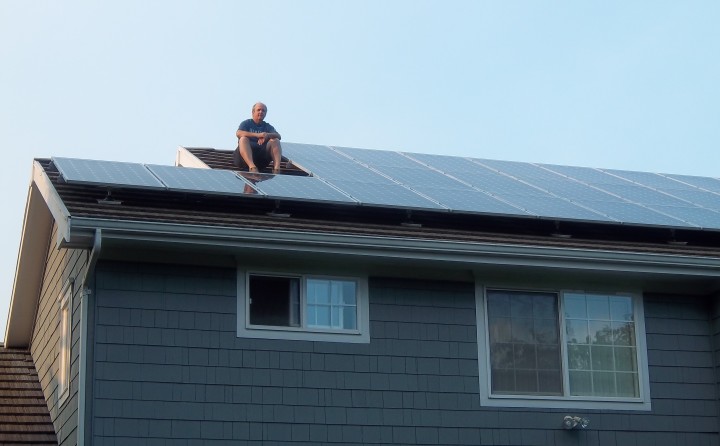
Does solar work in the “rainy” northwest?
This is a good question, and one that is commonly asked.
Yes, solar power works just very well in our area of Washington State. Here on the north Olympic and Kitsap Peninsulas we average approximately 3.5 hours of full sun per day. That is about 70% of the solar resources of southern California. However, unlike southern California most of our sunshine arrives between March and September when our electricity needs are low, especially for homes designed to not require air conditioning. If your system is tied to the grid, your summertime excess electricity generation can go back onto the grid, and may be used by your neighbor or effectively by Californians during their peak energy usage. You will get a a credit for every kwh you put onto the grid, and you will use those credits later, perhaps that night, perhaps not until winter.
For another comparison, western Washington on average receives more yearly sunshine than does Germany on average. This is significant because for the 10 years 2005 – 2014, Germany led the world in the number of installed solar modules with over 50% of the world’s deployed solar modules during that time (China has now become the world’s top installer of solar pv.) If Germany can effectively utilize solar power so can western Washington.
We see an annual variation of up to 15% even among the same solar pv systems due to weather variation of one year to the next. The summers are predictably good, the winters are predictably winter, and we see the variation mostly in the spring – some springs are notably sunny and some are cloudier extensions of winter. Depending on exactly where you live on the Peninsula, if your home is unshaded, you can count of seeing 1000-1200 kwh/year-KW.

Murney Residence
David & Barbara’s Solar PV Providing All Of Home’s & Car’s Electricity During Winter
David & Barbara Heid asked us to install a 12.4 KW Solar PV system on their new home. They felt compelled to provide the following review based on their experience so far.
—
Power Trip (PT) was instrumental in building our new “green” house. Several years ago PT was asked to survey our possible building site for potential solar energy capture. Their survey reported that the site had positive solar potential. That survey began our strong relationship with PT.
PT was with us from the beginning of our newhome. PT determined the compass orientation of the house foundation that would place the roof line for the greatest capture of solar energy. PT also designed the angle (slope) and size of the roof for placement of solar panels. PT also helped in our selection of the metal roof style that enhanced panel placement without having to penetrate the roof for panel anchorage.
Our “green” home is installed with a ductless heat pump for household heat, a ‘heat-pump’ hot water heater, and all lighting is LED. The house is insulated beyond county code requirements.
PT installed our solar panels on January 5, 2017. In addition to the panels, an EV (electric vehicle) charger station was installed. On April 28th , an all electric Chevrolet Bolt was purchased.
Today after 129 days since the installation of the solar panels, data collected shows that the ave daily energy use for the house is 32.87 kWh. So far, the ave daily Solar energy production is 32.07 kWh with a result of 97.57% of the daily household electrical use being supplied from Power Trip installed solar panels (32.07kWh/32.87kWh). The total household use of electricity includes the kWh used to charge the Bolt. The Bolt has been driven over 2000 miles since its purchase and it has been charged at our new home only.
Also, our PUD electric bills for March and April were only for the monthly $14.50 base fee that is charged to each electric bill. No charges were made for electricity since no electricity was delivered. In addition, the May PUD electric bill states that 396 kWh have been added to our banked usage balance.
We look forward to the days ahead when the ‘2017 spring rain season’ is replaced with some long days of sunshine and ‘banking’ energy for later winter days. Also with new batteries being developed, our future may include an ‘on site’ energy storage system.
Can we recommend Power Trip Energy for solar planning and installation? YOU BET!
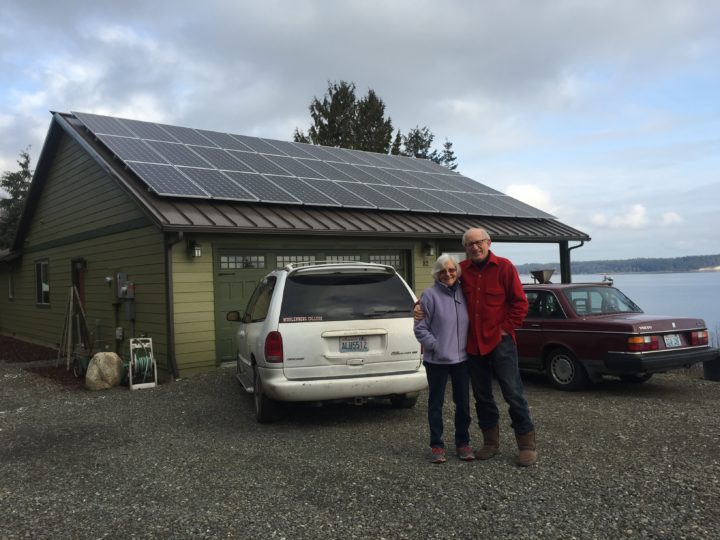
Heid Residence, 12.4 KW, Port Ludlow, Feb 2017
PSE offers “Solar Choice”
Puget Sound Energy (PSE), like all major utilities in Washington State, has long offered a Green Power program. This program allows you to enroll and pay an additional amount per kwh to get green energy. When we used to be PSE customers, we participated in the Green Power program in which we would pay a premium each month to make certain that what electricity we did buy from PSE (what we needed beyond what our solar pv produced), was sourced from clean energy sources. The main component in the Green Power program has been wind energy from a couple of large utility scale wind projects owned by PSE.
Now PSE is offering a solar specific green power program called Solar Choice. The Solar Choice program is similar to the existing Green Power program in that it offers customers the ability to pay a premium in order to make certain that PSE sources and allocates sufficient solar pv generated electricity to cover the amount you sign up to buy.
While this is very different from purchasing your own solar pv array for your own house, it is a good idea if you are a renter or have a shady roof and can’t install your own solar pv. The benefits are that you get the satisfaction of knowing there is some solar energy being produced somewhere with your name on those electrons, and you can participate or not as you choose. The more solar choices people have, the better.
If you own your house and have a sunny roof, its probably better to choose to make an upgrade to your house that will make clean power and decrease your home’s energy bills for decades.
https://pse.com/savingsandenergycenter/Renewables/Pages/default.aspx
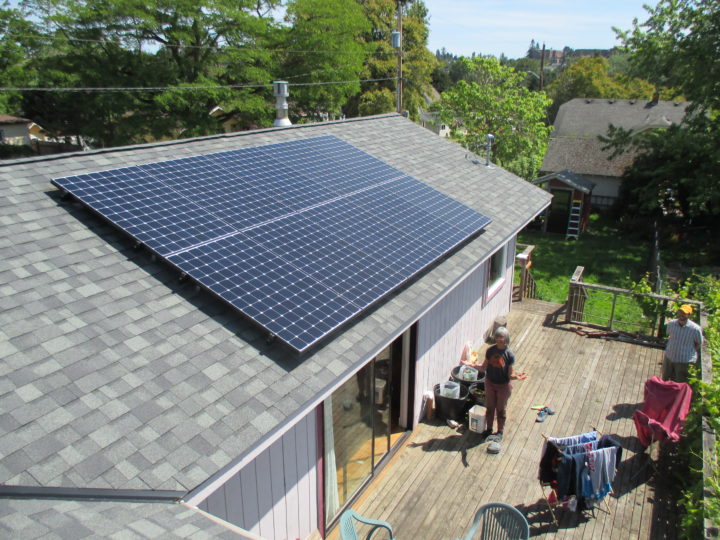
Palmer Residence, Dec 2016
Solar Roofing Updates – State of the Industry Survey
The solar business is fun and dynamic. It feels great to be working in an industry which provides a long-term solutions for some of the problems inherent in the energy status quo, and because the majority of people consider themselves supporters of solar, we get a lot of interest and support even from people that are not our customers. While solar photovoltaic panels have been made continuously since the 1950’s using the basic same materials and techniques, the industry itself is more dynamic than the technology. Many business leaders (including us) see nothing but opportunity for growth, indeed every sunny rooftop I see is a place where I think solar pv should be installed. The barriers are not technological, they are economic and social barriers only.
We are a small company assessing the market to determine the best options for our clients. Based on our years of experience, we have become practical and skeptical of flashy marketing. This practicality often comes up when people inquire about new products, and lately it seems like Tesla is again the center of attention. An incredible company led by a charismatic genius CEO, they now have the largest market capitalization of any US car manufacturer, despite the fact that Tesla sold 80,000 cars in 2016, and Ford sold 6.7 million cars for example. Valuations are as much about stories as balance sheets, and Tesla’s leaders are master story tellers. They are also masters of shaping their own reality, as evidenced by the quality of the cars they manufacture dubbed “Car of the Century” by Car and Driver http://www.caranddriver.com/reviews/2015-tesla-model-s-70d-instrumented-test-review, and by the fact that they have installed the largest utility energy storage facilities in the world with their Li-ion batteries. http://blog.solarcity.com/island-in-the-sun/
Regarding the solar roofs, Tesla has announced they will begin taking orders in April, aiming to begin installations by the end of 2017. They are currently advertising for and hiring roofers, indicating initially at least they will begin as contractors with in-house installers, as Solar City (a national solar installer now owned by Tesla) has done. Of note, the company has a history of taking orders very early, and delaying delivery dates significantly. If you need a new roof now, or if you want to utilize the 30% federal tax credit currently in place, you probably shouldn’t wait for this product.
Eric Wesoff provides a survey of a couple of new solar roofs and several unsuccessful BIPV (Building Integrated solar PV, an industry term for solar roofs) ventures here: https://www.greentechmedia.com/articles/read/Tesla-Says-It-Will-Take-Orders-for-the-Solar-Roof-in-April
Will Tesla again succeed where others have failed? We are looking forward to seeing what they can accomplish, and how it will relate to the other options available at the time. In the meanwhile, we won’t be holding our breath.
Regardless of what the future may hold, what we have to offer right now is better than any time in the past, more watts per square foot at a lower price, with proven technology and 25 year warranties. We invite you to learn more at one of our upcoming events, we look forward to seeing you. https://powertripenergy.com/events/
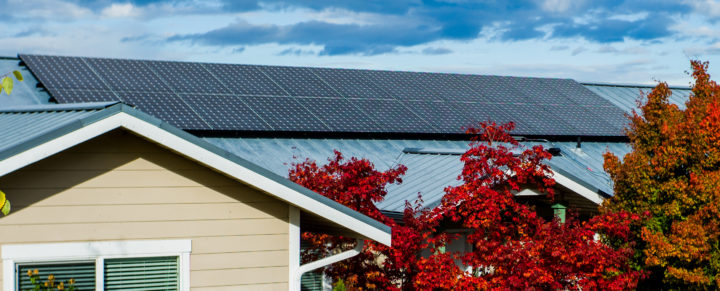
Meyer Residence, 7.6 KW (SunPower 345 watt modules) on the Clallam PUD grid in Sequim
Coming to a Sub-Station Near You, or “Why can’t I get a Tesla Power Wall Yet?”
Tesla was one of three companies that just brought online 70 Megawatts of instantly deployable lithium battery power, totaling approx 280 Megawatt-hours of energy storage. These projects were recently purchased by Southern California Edison (SCE) in response to the massive Aliso Canyon natural gas leak, which impacted gas supply for local plants, and the earlier than planned shut-down of the two San Onofre nuclear plants the company owns, due to premature wear which is still not understood.
This project represents the largest battery storage project in the world, and was completed faster than forecast, with a 100% safety record (no injuries during construction.) This 70 MW, represents the first step in a much larger eventual capacity for SCE. Some of the lithium battery storage they are deploying is on the customer side of the meter. This project is the main reason why you can’t get a Tesla Power Wall at the moment here on the Olympic Peninsula.
18 months ago, right after the initial Power Wall product announcement, I wrote that I hoped to see them within 12-18 months. 18 months later, I hope to see them in 12-18 months. Tesla is currently in “full production mode” at the Gigafactory outside Reno, NV, aiming to produce 50 Gigawatt-hours of battery capacity annually by next year, and eventually 150 Gwh annually. Gigafactory 2 has been announced for Europe, but no site has been determined yet. We can currently get products from other Lithium battery manufacturers that represent the first generation of this market, available for our clients who want to be on the cutting edge.
The synergy between utility scale solar pv and storage at the substation level is too sweet to ignore, and I expect to see continuing cost reductions and increase in the speed and efficiency of build-outs. In the meanwhile, if you have a sunny roof on your house, plain vanilla grid-tied pv is probably still your best option at the homeowner scale for the foreseeable future.
To learn more about the state of the art in Lithium battery deployment at the utility scale, Julia Pyper’s most recent article is a great place to start:
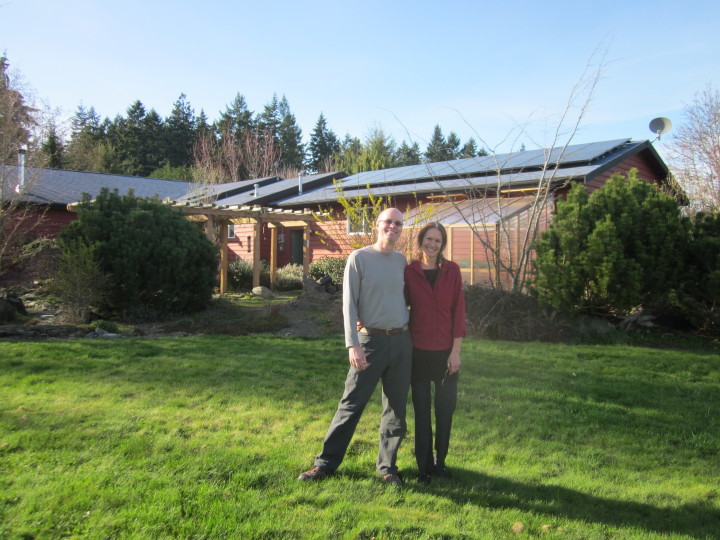
Chase-Tyler Residence
Solar Roof Tiles – Elon Musk and Tesla’s Further Plans to Revolutionize the Roofing Industry (In Addition to the Automotive and Utility Industries)
In November, Elon Musk spoke about Solar City’s plans to install solar roof tiles manufactured by Tesla. Many people have asked us about the potential of installing solar roof tiles. We look forward to seeing what becomes available and understanding the details of pricing and performance of this product. In the absence of any details from the manufacturer, you can look at pictures and sign up for updates here https://www.tesla.com/solar
This concept has previously been referred to by the nickname BIPV, denoting Building Integrated Photovoltaics, although we see that term used less these days. The concept of having one product that serves as roofing and also generates electricity is very attractive. It would be helpful to the product’s feasibility if the solar roof tiles cost less than the combination of a standard asphalt shingle roof with standard framed modules installed on top of it, but no solar roofing product that currently exists comes close to this price point. So in order to have a solar roofing product, customers will pay a premium. We have never installed one, though there have been many options available for over a decade, from Sharp Electronics, Open Energy, CertainTeed, and Dow, to name a few manufacturers. Musk claims that the Tesla solar roof tiles will cost less than a “dumb” roof. I look forward to seeing that, but I am not holding my breath while waiting.
The other solar roofing products on the market have a relatively low efficiency in terms of watts per square foot compared to standard mono-crystalline silicon modules. So even though there is the supposed convenience of a single product to install, the amount of energy that could be produced is actually lower than from a standard pv module array. In most residential installations, our design imperative is to produce as much energy as possible on the limited roof space available, so unless the Tesla product has a higher efficiency than the most efficient product currently available, it will involve making a sacrifice in performance. We are looking forward to the technical details to be able to make a true evaluation.
Only a portion of a home’s roof is practical for the installation of solar pv, eg, we would install solar on the south-facing roof, but not the north-facing roof of a simple house that is a single gabled rectangle. Most homes of course don’t have such simple roof shapes nor orientation. There are usually hips, dormers, clerestories and other roofs with different pitches and compass azimuths, and a big part of our design process is identifying and prioritizing the suitable roofs upon which to install pv. With the solar roof tiles, the question comes up as to what to do on the roofs not suitable for solar pv. Will Tesla provide a visually identical product minus the photovoltaic cells? I imagine this will be the intention, though this will surely raise the price further even for the roof planes not making energy.
Another aspect of this product that gives us pause is the need for a specialized tradesperson to perform the installation. In a solar installation on a standard home, the roof has been installed by roofing contractors who specify the products and warrant their roof installation for many years. The solar installers then install their product over the top of that and warrant our penetrations and product performance for many years. The roofers we work with are great, but it is a fair generalization to state that roofers are generally conservative and slow to adopt new products, which is exactly what you want in a roofer. As far as solar installers, they generally spend a lot of time surveying this rapidly changing market and keeping abreast of new products and dynamic pricing, updating their offerings for their clients as the options change and better products become feasible. There is an inherent tension in these two cultures, and the concept of combining those two trades into a single new trade is interesting. At Power Trip Energy, we have roofing skills related to penetrating, sealing, and flashing many different roof types in order to install our product on any roof, but we have no interest in becoming roofers at this time. In some situations with certain less common roofs or proprietary roofing membranes, we coordinate our installation with the roofers who follow us on the roof and come in right after us to flash our work and maintain responsibility for the entire roofs warranty. Perhaps other larger markets will lead in the creation of a new trade specialist, the solar electrician roofer, but we have yet to see evidence of that in the trade literature. If the installation will require coordination roofers and solar electricians, that coordination will inherently increase the cost of installation and inevitably slow us down.
There are unanswered design questions. Currently, if we are designing a system using string inverters that accept strings of DC electricity from the solar pv on the roof, we need to make certain we are bringing the DC power to the inverter with the proper voltage and amperage, sometimes a challenge to fully and exactly utilize available roof space. What will be the design constraints of these solar roof tiles? More often now instead of string inverters, we are using AC modules each with integrated micro-inverters in the 320 watt range, on a module that is roughly 15 square feet in area. If each solar roofing tile were to have its own integrated micro-inverter on a much smaller scale, that would increase costs and dramatically multiply the potential points of failure, and increase the complexity and expense of any warranty work. I doubt whether we will see solar roof tiles with integrated micro-inverters any time soon, but this is exactly where the leading edge of the market is right now for the standard framed modules.
Unless the solar roof tiles can provide some benefits that surprise me in relation to the issues I raised above, the only benefit is the aesthetics some people will find in the look of those roofs. We have been able to design systems to satisfy even the most aesthetic conscious clients using SunPower’s black-framed modules. Of course most of our clients find the creation of clean energy a thing of beauty in itself, and are happy to be reminded of their arrays when they come home.
Please pardon our slightly jaded response to some of the industry’s more hopeful forward-looking announcements, we have seen a lot of those in the last 14 years, and it is a rare jewel that makes it from announced intention to actually becoming the best product for your roof. We’ll be keeping a close eye on these developments and let you know when they are ready for you. In the meanwhile, what we have right now is a selection of the best solar products made to date, at the lowest prices ever seen, and a relatively friendly regulatory environment, facts which may combine to encourage you to act now rather than following Tesla’s implied advice to continue waiting for something better.
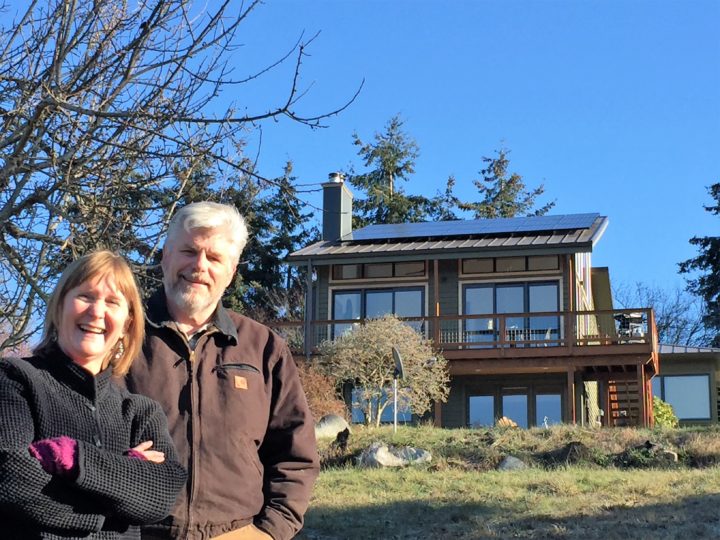
The Incoming Trump Administration’s Energy Statement
The incoming administration’s position on energy provides interesting insight into what is to be expected from the federal government in the next four years. The new administration will surely be friendlier to coal mining, oil drilling onshore and offshore, and fracking for natural gas.
https://greatagain.gov/energy-independence-69767de8166#.zce8a6e9p
If implemented, those strategies will degrade our natural environment, lease our public lands to their cronies at low rates, increase our transfer rate of carbon currently locked in the ground into the air as CO2, increase our contribution to climate change, and increase your dependence on the oil tyrants.
My personal response will be to enlarge the solar PV arrays at my home and business, and make certain as much of my driving as possible is in an electric vehicle.
In this way I can decrease my personal contribution to the negative aspects of the administration’s carbon-based fossil fuel plans, and minimize my financial support of the centralized energy corporations, while keeping more of my money available to invest in my own family’s future.
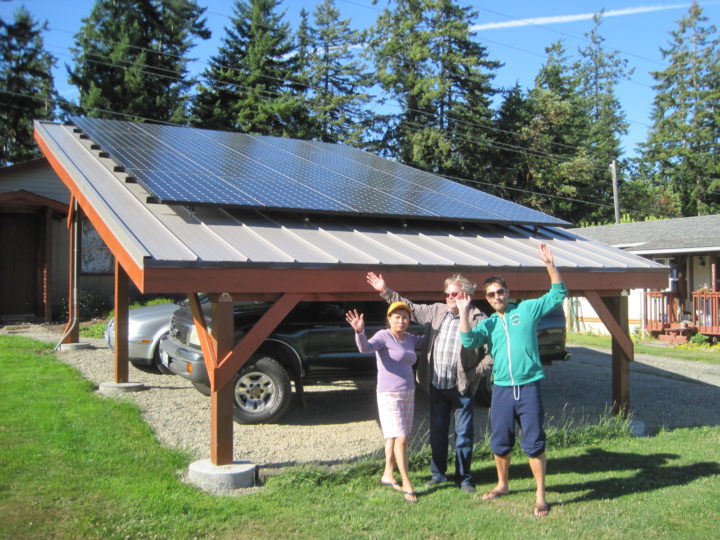
Morgan Residence, 6.9 KW SunPower, Port Angeles, June 2016
Mandatory solar power: The wave of the future?
I recently read about two towns in California that have mandated the installation of grid-tied PV systems on newly constructed homes. This government legislation illustrates to me how far residential solar power has come. Just a couple of decades ago, solar power brought to mind one solar panel powering a flickering light bulb hanging from the ceiling of a wood cabin. And now City Councils are insisting upon solar! The passing of these laws leaves me wondering if legally mandating solar installations is a growing trend and what will this mean for the future?
The town of Sebastopol has about the same population as Port Townsend, Washington, around 8000 souls. In 2013, this quirky and decidedly liberal town passed a law requiring solar panels on all new buildings and additions with nearly unanimous support from its City Council. According to a May 10, 2013 article by Miranda Green of The Daily Beast, “Sebastopol’s ordinance orders that the solar systems must provide 2 watts of power per square foot or offset 75 percent of the structure’s electricity use.” So a humble 3.6 KW system would be required on an 1800 sq ft home.
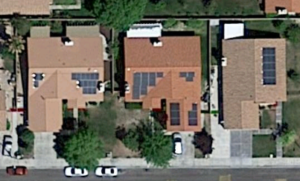
Lancaster, California was the first city in the United States to mandate solar panels on new construction. Photo: Map data ©2016 Google
Unlike Sebastopol, Lancaster, California is largely politically conservative. It has a population of around 150,000, about the same as the Washington State counties of Clallam, Jefferson, and Mason combined. According to Green, Lancaster was the first city in the United States to mandate solar panels on new construction. The city council was unanimous in approving a zoning code amendment requiring housing developers to add solar power systems on all new homes. This new code was initiated by the Republican mayor, R. Rex Parris, who wanted to make Lancaster the “solar capital of the universe.” The satellite photo of Lancaster above shows a segment of a housing development impacted by the legislation.
A Marketplace.org article posted on August 11, 2016, by Jed Kim addresses the question of mandating solar power. According to Kim, “Santa Monica recently approved an ordinance making rooftop solar systems mandatory for all new construction and major renovations.” San Francisco is planning on implementing similar legislation in 2017. Dean Kubani, Santa Monica’s chief sustainability officer, explained that the ordinance was approved to aid the city’s efforts to reduce emissions, “We, like a lot of other cities, are looking at greenhouse gas impacts and carbon impacts, and we’re trying to figure out how can we become carbon neutral.”
In the greentechmedia.com article, What It Really Means to Require Solar Panels on All New Buildings (June 20, 2016), Julian Spector writes, “Other municipalities have already reached out to San Francisco for more information about the policy, including Boston, Washington, D.C., Cambridge and Palo Alto.” Spector concludes, “The endgame will be cities where rooftop solar isn’t a personal challenge for a homeowner, it’s just one of many components expected of a market-ready property.”
It seems clear that mandating solar power is indeed a growing trend. However, I am hesitant to assert that solar power should be mandated for all new construction across the country. All too frequently, legislation that is meant to help people ends up presenting unintended consequences and sometimes does more harm than good. What are the possible unintended consequences of legislating solar installations? How successful are other incentive programs and commercial promotions in encouraging people to adopt solar power? If we wait for the market to come around to solar, will it happen fast enough to mitigate our climate crisis? What do you think? What questions do you have about this topic or other issues with solar power?
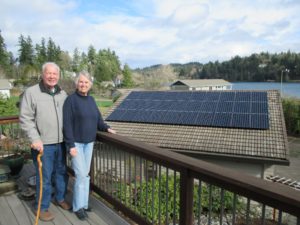
Proud new owners of a Power Trip Energy solar array, 2016
Is it too late to be an early adopter?
If you are like most environmentally conscious people, solar power has been on your radar for a very long time. You may have even developed a habit of waiting for the technology to become more solid, mainstream, and affordable; waiting for the first wave of users to help work out the kinks and develop a perfected product. Until about three weeks ago when I began my research on the Solar Agent position at Power Trip Energy, I thought we were still in waiting mode.
As my training on grid-tied PV has progressed at Power Trip Energy, it has dawned on me that the “early adopter” phase for residential solar power may have already passed. My family has always been the sort who are first on our block to embrace such things as microwave ovens and home computers, cell phones and Netflix. Thankfully, we can keep our technological early adopter self-image intact. Despite the fact that residential solar power has become so mainstream that we can now share our democratized power production with the utility grid and be paid for it at 100% the utility’s selling rate, we can still be the first on our block to invest in a flashy and affordable new solar array!
Your wait is truly over. Residential grid-tied PV solar technology has become more than a logical investment in the future livability of our planet; it has also become fiscally practical, paying for itself over time, increasing our property values, and significantly reducing our power bills immediately. Power Trip Energy was brave enough to show up early and paddle out to the big wave. Now they, I mean WE, are ready to join you in riding that wave back to shore.
What strikes me most about the super awesome community members at Power Trip Energy is their integrity and commitment to our habitat. From the electric personal cars and bicycles in our parking lot to partnering with companies that insist on producing solar modules sustainably, Power Trip Energy is making a real impact on our future for generations to come. I am honored to join them in this powerful movement and eager to share the electricity with you!

Photo taken on Puget Sound Express‘s Glacier Spirit whale watch touring vessel. Hudson Point Marina is in the background. Heather Flanagan is the newest member of the Power Trip Energy team. Originally from Portland, Oregon, she now calls Port Townsend her home. Heather lives in Uptown with her two boys, Logan and Blake.